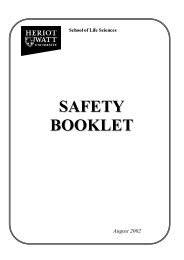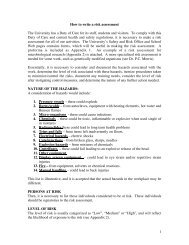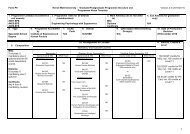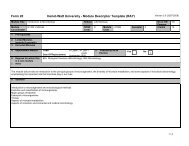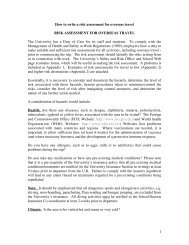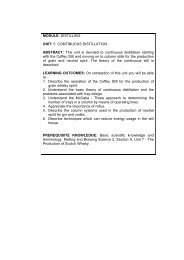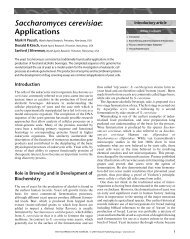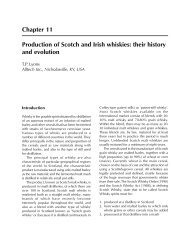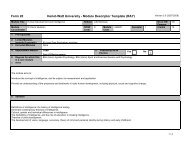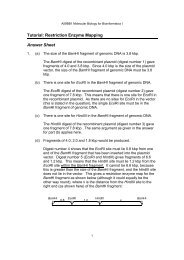Big Five Factors of Personality and Replicated Predictions of Behavior
Big Five Factors of Personality and Replicated Predictions of Behavior
Big Five Factors of Personality and Replicated Predictions of Behavior
Create successful ePaper yourself
Turn your PDF publications into a flip-book with our unique Google optimized e-Paper software.
BIG FIVE PREDICTORS<br />
417<br />
Table 3<br />
<strong>Replicated</strong> Partial Correlations (With Sex Removed) Between Criteria <strong>and</strong><br />
<strong>Big</strong> <strong>Five</strong> Factor Scales<br />
Criterion<br />
Factor scale<br />
FF–NPQ<br />
(n 178)<br />
FF–NPQ<br />
(n 142)<br />
NEO–FFI<br />
(n 273)<br />
NEO–PI–R<br />
(n 135)<br />
Participant sex a Neuroticism .53*** .54*** .31*** .20*<br />
Agreeableness .33*** .23** .25*** .23**<br />
Conscientiousness .19** .30*** .06 .22*<br />
Intelligence Neuroticism .23** .12 .30*** .33***<br />
Openness .13* .24** .25*** .32***<br />
Conscientiousness .07 .17* .20*** .36***<br />
Alcohol consumption Extraversion .30*** .33*** .14* .24**<br />
Conscientiousness .21*** .15 .26*** .29***<br />
Honesty Agreeableness .23*** .19* .17** .26**<br />
Conscientiousness .25*** .12 .27*** .27***<br />
Popularity Extraversion .39*** .36*** .39*** .51***<br />
Parties attended Extraversion .31*** .33*** .29*** .33***<br />
Grade point average Conscientiousness .23*** .13 .27*** .19*<br />
Plays musical instruments Openness .19** .24** .19** .20*<br />
Attractiveness Extraversion .25*** .07 .35*** .18*<br />
Tobacco consumption Agreeableness .23*** .16 .26*** .18*<br />
Dating variety Extraversion .17** .24** .07 .28***<br />
Routinely exercises Extraversion .23*** .18* .29*** .14<br />
Note. FF–NPQ <strong>Five</strong>-Factor Nonverbal <strong>Personality</strong> Questionnaire; NEO–FFI NEO <strong>Five</strong>-Factor Inventory;<br />
NEO–PI–R Revised NEO <strong>Personality</strong> Inventory.<br />
a Participant sex was not partialed.<br />
* p .05. ** p .01. *** p .001.<br />
Of the remaining 42 evaluations (60 18), 37 replicated across<br />
data sets with nonsignificant predictions (i.e., 88%). Thus, in<br />
only 5 cases (12%) were there some noteworthy disagreements<br />
among the four personality assessments in terms <strong>of</strong> whether a<br />
particular factor predicted a particular criterion. What <strong>of</strong> the predictions<br />
<strong>of</strong> the other 15 criteria not listed in Table 3? Their absence<br />
from that table means that none <strong>of</strong> those criteria met my st<strong>and</strong>ard<br />
<strong>of</strong> replicated significant predictions. For the st<strong>and</strong>ard <strong>of</strong> replicated<br />
null predictions, however, the large majority <strong>of</strong> the results for<br />
those 15 criteria showed consistency. Of the 75 evaluations <strong>of</strong><br />
replicated null effects (five factors 15 criteria), 67 <strong>of</strong> them<br />
agreed in their results across the different <strong>Big</strong> <strong>Five</strong> assessments<br />
(89%).<br />
Nonreplicated <strong>Big</strong> <strong>Five</strong> Predictors<br />
The present evaluations <strong>of</strong> the predictive generalizability <strong>of</strong> <strong>Big</strong><br />
<strong>Five</strong> factor measures across different inventories have shown substantially<br />
positive results overall, in terms <strong>of</strong> both replicated significant<br />
predictions <strong>and</strong> replicated null predictions. But there may<br />
be an additional informative value in studying the discrepant<br />
findings, in which some <strong>Big</strong> <strong>Five</strong> factor measures predicted a<br />
criterion but others did not. The specific discrepancies in factor–<br />
criterion predictions found in this study, based on correlations that<br />
failed the above-mentioned tests for replicated significant <strong>and</strong><br />
replicated nonsignificant results, are listed in Table 4. The 13<br />
behavior criteria listed in that table have been organized to highlight<br />
possible reasons for the discrepant findings in those particular<br />
cases.<br />
Note the pattern <strong>of</strong> factor–criterion relations for the four personality<br />
assessments <strong>and</strong> the first seven criteria listed in Table 4.<br />
In each <strong>of</strong> those cases, the verbal NEO–FFI <strong>and</strong> NEO–PI–R<br />
questionnaires resulted in the same factor predicting the same<br />
criterion, whereas the nonverbal FF–NPQ measures failed to replicate<br />
those results. This pattern <strong>of</strong> correlations suggests that there<br />
is possibly some difference in the content <strong>of</strong> the verbal <strong>and</strong><br />
nonverbal scales that gives one an advantage over the other in the<br />
prediction <strong>of</strong> certain criterion variables. As an example, the NEO–<br />
PI–R Neuroticism scale contains statements intended to measure<br />
self-consciousness, referring to a tendency to suffer feelings <strong>of</strong><br />
inferiority or discomfort when being scrutinized by others. Such<br />
behaviors are difficult to convey with nonverbal personality items<br />
<strong>of</strong> the type used in this study <strong>and</strong>, therefore, are not represented in<br />
the FF–NPQ Neuroticism measure. This might explain why the<br />
verbal Neuroticism scale but not the nonverbal scale predicted<br />
(low) self-perceived attractiveness.<br />
The next four criteria listed in Table 4 (Rows 8 to 11) show<br />
systematic discrepancies in factor–criterion correlations across the<br />
two independent samples <strong>of</strong> participants. Specifically, Agreeableness<br />
predicted religiosity, <strong>and</strong> Openness to Experience predicted<br />
preference for liberal arts study in the smaller sample <strong>of</strong> participants<br />
(n 142) but not in the larger sample (n 276). The<br />
opposite sample effects were true for Agreeableness predicting<br />
dieting behavior <strong>and</strong> driving fast, both being significant (<strong>and</strong><br />
negative) in the larger sample but not in the smaller sample. These<br />
results suggest that the participants in the two samples may have<br />
had slightly different personality compositions or different underlying<br />
behavior determinants.<br />
The discrepant correlations for the last two factor–criterion<br />
combinations listed in Table 4 (Rows 12 <strong>and</strong> 13) are not interpretable<br />
in terms <strong>of</strong> differences in the verbal versus nonverbal personality<br />
assessments. Nor are they interpretable in terms <strong>of</strong> Sample 1<br />
versus Sample 2 participant differences. It is likely that those



